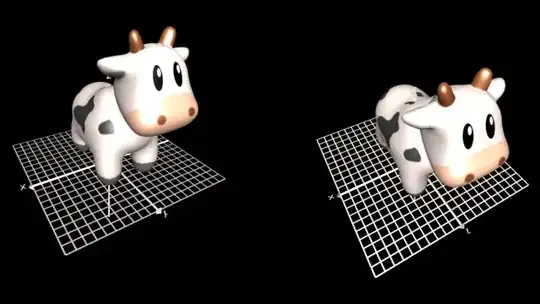A rotation around the x-axis is achieved by this matrix
$$
\mathtt{T}_\mathrm{rot X} = \begin{bmatrix} 1 & 0 & 0 & 0 \\ 0& \cos \alpha
& -\sin \alpha& 0 \\ 0 & \sin \alpha & \cos \alpha & 0 \\ 0 & 0 & 0 &1 \\ \end{bmatrix}
$$
In order to rotate around the x-axis in the viewing space, one needs to think about when to apply the above transformation in the chain of transformations that is applied to the 3D model vertices $\mathbf{X}_{\mathrm{3d}}$ in the employed rendering pipeline.
A typical transformation chain is:
$$
\mathbf{X}_{\mathrm{view}} = \mathtt{T}_{\mathrm{projection}} \,\mathtt{T}_{\mathrm{camera\ transform}}\,
\mathtt{T}_{\mathrm{mesh\ transform}}\,\mathbf{X}_{\mathrm{3d}}
$$
Let's split the camera tranformation into its rotational and translational part:
$$
\mathbf{X}_{\mathrm{view}} = \mathtt{T}_{\mathrm{projection}} \,\underbrace{\mathtt{T}_{\mathrm{cam\ trans}}\,\mathtt{T}_{\mathrm{cam\ rot}}}_{\mathtt{T}_{\mathrm{camera\ transform}}}\,
\mathtt{T}_{\mathrm{mesh\ transform}}\,\mathbf{X}_{\mathrm{3d}}
$$
Then we need to apply the x-rotation in-between the camera rotation and translation, because we want to have the rotation of the camera applied beforehand, but not the camera's translation:
$$
\mathbf{X}_{\mathrm{view}} = \mathtt{T}_{\mathrm{projection}} \,\underbrace{\mathtt{T}_{\mathrm{cam\ trans}}\,\mathtt{T}_\mathrm{rot X}\,\mathtt{T}_{\mathrm{cam\ rot}}}_{\mathtt{T}_{\mathrm{new\ camera\ transform}}}\,
\mathtt{T}_{\mathrm{mesh\ transform}}\,\mathbf{X}_{\mathrm{3d}}
$$
This would achieve the desired rotation, but typically we do not want to change the camera transformation but the the mesh transformation. This is achieved by
$$
\mathbf{X}_{\mathrm{view}} = \mathtt{T}_{\mathrm{projection}} \,\mathtt{T}_{\mathrm{cam\ trans}}\,\mathtt{T}_\mathrm{rot X}\,\mathtt{T}_{\mathrm{cam\ rot}}\,
\mathtt{T}_{\mathrm{mesh\ transform}}\,\mathbf{X}_{\mathrm{3d}}\\
\Leftrightarrow \mathbf{X}_{\mathrm{view}} = \mathtt{T}_{\mathrm{projection}} \,\mathtt{T}_{\mathrm{cam\ trans}}\,(\mathtt{T}_{\mathrm{cam\ rot}}\,\mathtt{T}_{\mathrm{cam\ rot}}^{-1})\,\mathtt{T}_\mathrm{rot X}\,\mathtt{T}_{\mathrm{cam\ rot}}\,
\mathtt{T}_{\mathrm{mesh\ transform}}\,\mathbf{X}_{\mathrm{3d}}\\
\Leftrightarrow \mathbf{X}_{\mathrm{view}} = \mathtt{T}_{\mathrm{projection}} \,\mathtt{T}_{\mathrm{camera\ transform}}\,\underbrace{\mathtt{T}_{\mathrm{cam\ rot}}^{-1}\,\mathtt{T}_\mathrm{rot X}\,\mathtt{T}_{\mathrm{cam\ rot}}\,
\mathtt{T}_{\mathrm{mesh\ transform}}}_{\mathtt{T}_{\mathrm{new\ mesh\ transform}}}\,\mathbf{X}_{\mathrm{3d}}
$$
Therefore, the short answer to your question is:
Left-multiply the current transformation matrix of your model with $\mathtt{T}_{\mathrm{cam\ rot}}^{-1}\,\mathtt{T}_\mathrm{rot X}\,\mathtt{T}_{\mathrm{cam\ rot}}$.

I have generated an "cow" example scene in the GSN Composer that can be used for interactive testing in a WebGL-capable browser:
Example: CowQuestion | GSN Composer
